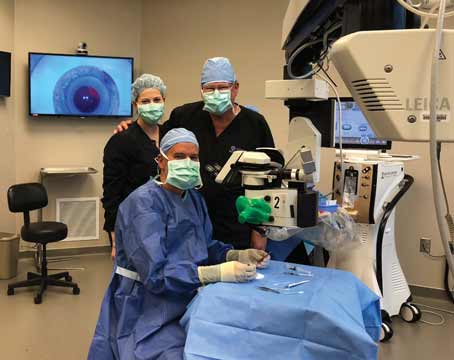 |
While marketing itself hasn’t changed much over the years, the way it’s executed has. Patients today expect a good online experience, so it’s important to keep your web presence updated—operationally and content-wise. In this article, you’ll learn tips for optimizing your digital marketing efforts to attract and retain both patients and referral sources.
Digital Marketing
“Digital marketing has become a huge tool for growing practices,” says Dagny Zhu, MD, medical director and practice owner of Hyperspeed LASIK-NVision in Rowland Heights, California. “Direct-to-consumer marketing is crucial for refractive practices, because many of our services are elective and we don’t have a large insurance network of patients to draw from.”
She uses what she calls a “push-and-pull” strategy to increase awareness of her brand and draw in patients. “Push marketing is useful for getting your brand out there or prompting people to start thinking about getting LASIK or elective refractive surgery,” she says. “In general, it’s more expensive because it targets a broader population who may not be looking for eye surgery services. Pull strategies such as Google ads are less expensive because they’re targeted and based on the number of views or clicks.”
“Any marketing strategy has three basic steps: differentiate; get found; and convert,” says Jim Flynn, an AAOE Consultant and executive vice president and chief brand strategist of OneFire, a marketing firm in Peoria, Illinois. “There are many ways to do this, but all three steps are essential.”
Differentiate
As you craft or reevaluate your digital marketing plan, in addition to marketing your services, you’ll also need to set yourself apart from your competitors. “Differentiating your practice is key,” Mr. Flynn says. “Your practice isn’t the same as the practice across town. You have something that’s unique—maybe it’s the way you interact with patients or the way you run your practice. Ensure that your staff understands what this means so they can consistently communicate it to patients. Every other marketing-related thing you do will be more effective.”
Get Found (Online)
Online platforms are powerful for attracting younger patients, which is ideal for a practice with a refractive surgery focus. “It’s not uncommon for someone to come into the clinic purely because of what they read on Yelp,” says Amir Marvasti, MD, of Coastal Vision Medical Group in Orange County, California. “This seems to have become more common than word-of-mouth advertising.”
Your choice of platform will be influenced by your target audience. “A common pitfall of digital marketing is having no clear idea of the target audience,” Mr. Flynn says. “If you’re a general ophthalmologist, your target audience includes all ages, but skewed 65 and older. A LASIK practice, on the other hand, will be marketing to an 18- to 35-year-old crowd, skewing older if they also correct presbyopia.
“Most clients today are using digital media as the largest percentage of their overall media spend,” Mr. Flynn says. “There are many platforms for digital marketing, but you shouldn’t feel pressured to use all of them—one or two, done well, is sufficient.”
Bear in mind that digital platforms usually involve communication of some kind, such as comments, reviews, live chat or direct messaging. “In the post-COVID world, patients have come to expect good digital communication experiences—when they want and how they want,” Mr. Flynn notes. “A practice can be competitive just on the basis of being easier to communicate with.”
Here’s a breakdown of the main components of a comprehensive digital marketing strategy:
• SEO. Because getting found online nearly always begins with a search engine query, experts say you can’t ignore search engine optimization in your digital marketing strategy. Optimizing your website and any affiliated online platforms will increase your chances of appearing on the first page of search results and increase your website’s ranking with Google.
“Only 10 percent of people go to the second page of Google results,” Mr. Flynn says. “Ninety percent of searches end on the first page, and 70 percent of those people click on one of the top four search results, which are usually paid ads.”
Optimizing begins with strong keywords and relevant content. “Patients are asking questions when they search online, so your content needs to answer these questions,” he continues. “Using appropriate keywords will increase patients’ chances of finding your content. Watch what terms come up when you start typing in the search bar—those are the words people are searching for. You can also search for ‘free keyword tools’ to find out what keywords people are using.”
Dr. Marvasti says his marketing team analyzes keywords and phrases to fine-tune marketing spending. “We’ll spend more dollars on the more commonly searched words and phrases,” he says. “With geo-targeting, we can also see which search terms are used in different neighborhoods.” He advises researching your local community and asking for consistent feedback from your patients about what online platforms they use.
• Paid search. Paid search, such as Google Ad Words, will bring your digital ads directly to people when they’re searching. “Again, 70 percent of people click on the first four results, so you want to be up there,” Mr. Flynn says.
Google’s local search, which often features an interactive map, is another section you’ll want to show up in, since your patients are likely to be from the local community. “When we opened new practice locations, we used Google Ads to help to get the word out and attract patients, since our name was new in those areas,” says Dr. Marvasti. Mr. Flynn recommends hiring an optimization service for your online platforms, especially if your practice has multiple doctors or locations, which sometimes confuses Google.
| Marketing to Referral Sources Marketing to doctors—whether they’re optometrists, general ophthalmologists or subspecialists—requires some adjustments in both strategy and content, but a strong digital presence will still serve you well. “You need to have what I refer to as ‘helping’ or ‘thought leadership’ content on your website in two ways: patient-facing content and doctor-facing content,” says Mr. Flynn. “Patient-facing content that provides accurate, useful information will help patients feel better about their referrals, because it demonstrates that you have a high-quality practice,” he says. “It will also help the patient ask intelligent questions about their options and related care or treatment. “For doctor-facing content, you might include some interesting pathology in a section for doctors on your website, or speak in a video about a diagnosis and discuss the available options. Helping to educate referral sources is important and builds trust,” he says. Dr. Zhu says another way to incorporate doctor-facing marketing is by hosting regular educational webinars and virtual CEs. “These are great ways to get your name out there and foster good relationships,” she says. These may also be in-person events, such as a Saturday or evening CE class taught by the doctor. “It can be as easy as a wine and cheese reception after practice hours,” says Mr. Flynn. “Invite doctors from the community, maybe deliver a short set of comments. It’s more social than clinical, but a combination of these two has been very successful for practices.” —CL |
• Social media. Many medical professionals have begun using social media platforms as marketing and educational tools. Advertising with these platforms will cost money, but posting organic content is free.
“Social media is an excellent option not only for advertising your services but for educating and establishing your trustworthiness and expertise as an eye specialist,” Dr. Zhu says. “However, it can be more time-intensive to create unique and educational content, compared to traditional marketing. To succeed with social media marketing, it should be authentic to you.” Dr. Zhu has created educational videos addressing topics such as LASIK myths, safe contact lens use, home remedies for dry eye and vision development in babies.
Instagram and Facebook are the most used social media platforms for marketing, in part because they have high engagement. This year, the Pew Research Center reported that in the United States 70 to 73 percent of adults aged 18 to 64 and half of adults over 65 said they use Facebook. Self-reported Instagram use was highest among those aged 18 to 29 and 30 to 49 (71 percent and 48 percent, respectively).1
Instagram is owned by Facebook. To advertise on either, all you need is a Facebook Business page and the Ad Manager tool. The cost of advertising—cost-per-click—varies, based on factors such as time of year (it tends to increase as the year goes on) or target sex or age group (slightly higher among 18- to 24-year-olds and higher among females than males).2
Dr. Marvasti says he advertises on both Facebook and Instagram. “I share patient stories and patient comments, updates on new technology or procedures in the field and information about the technology that I use,” he says. “A combination of these has yielded good results.”
Mr. Flynn describes paid social media ads as akin to subliminal messages. “It’s a branding play,” he explains. “The person sees your content just because they ran across it in their feed. They weren’t searching for LASIK information, say, but they happened to see it. Then if they do search for it and see your content again, it’ll jog their memory and you’ll have familiarity on your side. It has conversion opportunities, but it’s generally not as high as paid search.”
• Websites. If your website’s content management system isn’t current, you won’t be able to take full advantage of SEO. “Older content management systems don’t accommodate some of the off-site technical SEO that’s necessary,” says Mr. Flynn. “If your website platform is five or 10 years old, chances are it’s not optimized for today’s browsers—particularly mobile browsers. If you’re not optimizing for mobile, you’re absolutely disappointing your patients, because they’re not getting a good experience with your website. Websites that look and perform like they’re out of date won’t serve you well.”
There are many website platforms, but Mr. Flynn says that WordPress is a popular choice. “Its open-source CMS is optimized for all platforms and it has the largest base of independent contractors and companies that support its CMS,” he says. He advises using Google Analytics or Google Tag Manager to track your site’s performance.
• Quality content. In addition to keeping your website’s CMS updated with the latest software upgrades, you’ll also need to post regularly to ensure your site ranks well with Google. “There are three types of content: evergreen content; fresh, relevant content; and downloadable content,” Mr. Flynn says.
“Evergreen content is content on your webpages that’s accurate the day it’s written as well as six months in the future, or even a year from now,” he says. “The second type, known as ‘fresh, relevant content’ is rated very highly by Google’s latest algorithm. Relevance by Google’s standards is when people find the site through appropriate keywords and stay on the site. Google likes it when people stay on a site because that means there’s good-quality content. Fresh, relevant content increases your quality score with Google, and Google then raises your page’s organic rank. If people bounce off your site quickly, that lowers your organic ranking.”
He says the best way to deliver fresh, relevant content is on a blog. “Post short articles —500 to 750 words—once or twice a week,” he advises. “Google likes changing content—the ‘fresh’ part—posted on a regular basis.”
“We write blog posts in response to frequently searched questions and phrases,” Dr. Marvasti notes. “For example, ‘can I get LASIK if I’m planning to become pregnant?’ or ‘LASIK and dry eye’ are common topics people search for, so we make a blog post, put it on our website and link it to Google Ads.”
Downloadable content is another strong conversion tool. “Using your thought leadership as a medical provider can convert site visitors into leads into patients,” Mr. Flynn explains. “An example of downloadable content is an ebook. If you’re a LASIK surgeon, this ebook might be on the 10 most important things for understanding if LASIK is right for you. A person will come to your website because they see that ebook, or they see it offered in a blog post that discusses LASIK. The landing page for the ebook may have a form to fill out, asking for first and last name and email address. When patients submit the form, they can download the ebook, and now the practice has a lead it can nurture with more content.” In this case, Mr. Flynn says don’t forget to include a privacy statement, seeking permission for the practice to communicate electronically with the person.
Building A Marketing Team
Your marketing team makeup will depend on your practice’s complexity (i.e., the size of your practice, and the number of doctors and subspecialties). If you have a practice administrator, they may oversee marketing on a strategic and accountability level, but they generally won’t have time to be running the strategic portion of marketing. “You’ll likely need an internal marketing person,” Mr. Flynn says. “Who you hire will determine which outside resources you engage with (e.g., web developer, ad agency, media firm). A mix of internal and external expertise works best.
“A successful marketing program requires a lot of different skillsets,” he continues. “It’s difficult to get somebody who ticks all the boxes. Generally, I see practices wanting to hire an introductory-salary-level person because they believe young people understand social media. A new college graduate may very well understand social media, but that doesn’t mean they understand marketing or monetizing social media. Understanding how to use the tool is different than being able to use it to market effectively.
“You need to have somebody who’s part strategy, part technical website builder, part Google Ads manager and part analytics,” he continues. “It’s difficult to find that all in one person, and very few entry-level-salary individuals have those skillsets. Another challenge is what to do about turnover. How do you back yourself up if your main marketing person leaves? It’s important to have a plan so your marketing doesn’t go dark for several months.”
Drs. Zhu and Marvasti have no related financial disclosures. Mr. Flynn is the executive VP and chief brand strategist of the marketing firm OneFire.
1. pewresearch.org/internet/chart/who-uses-facebook-instagram-linkedin-and-twitter. Accessed April 28, 2021.
2. adespresso.com/blog/instagram-ads-cost. Accessed April 28, 2021.





